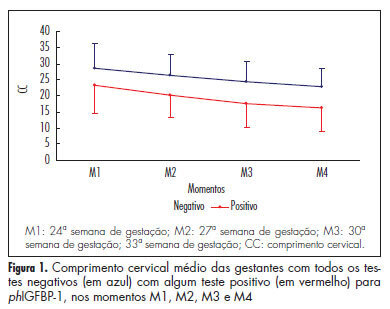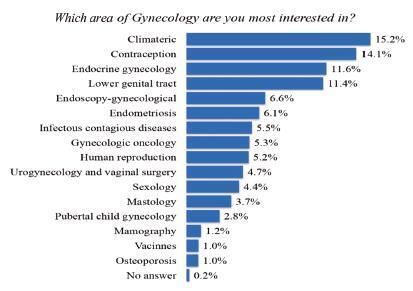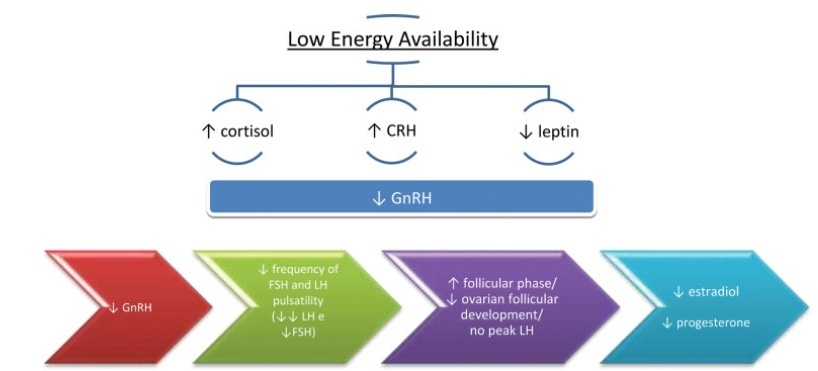Summary
Revista Brasileira de Ginecologia e Obstetrícia. 2013;35(9):394-400
DOI 10.1590/S0100-72032013000900003
PURPOSE: To investigate the usefulness of the measurement of cervical length and of the test for phosphorylated insulin-like growth factor binding protein-1 (phIGFBP-1) performed sequentially in the prediction of preterm birth and the correlation between tests. METHODS: We analyzed data from 101 asymptomatic pregnant women with a history of premature delivery. The ultrasound measurement of cervical length and phIGFBP-1 test were performed in parallel every three weeks, between 24 and 34 week. The best cutoff value for each cervical evaluation was established by the ROC curve, and the two tests were compared using nonparametric tests. We determined the sensitivity, specificity and predictive values of each test and of the association of the exams for the occurrence of delivery before the 37th weeks. RESULTS: There were 25 preterm births (24.8%). The cervix length showed the highest sensitivity and was able to predict preterm birth in all evaluations, with similar accuracy at different gestational ages. The test for phIGFBP-1 was not helpful at 24 weeks, but was able to predict prematurity when performed at 27, 30 and 33 weeks. The combination of tests increased the sensitivity (81.8%) and negative predictive value (93.7%) when compared to the separate use of each test. The mean cervical length was lower in women with a positive test. CONCLUSIONS: Both cervical length and the test for phIGFBP-1 were able to predict premature delivery, and sequential combination of both tests showed a high sensitivity and high negative predictive value.

Summary
Revista Brasileira de Ginecologia e Obstetrícia. 2019;41(6):394-399
The present study aims to obtain basic demographic information, the level of interest and of training in gynecology oncology among Brazilian obstetricians and gynecologists (OB-GYNs) to create a professional profile.
An online questionnaire was sent to 16,008 gynecologists affiliated to the Brazilian Federation of Associations of Gynecology and Obstetrics (FEBRASGO, in the Portuguese acronym). We considered gynecologists dedicated to gynecologic oncology (OB-GYNs ONCO) those who self-reported that > 50% of their daily practice consists in working with women’s cancer care.
A total of 1,608 (10%) of 16,008 FEBRASGO members responded. The OBGYNs are concentrated in the southern and southeastern states of Brazil. Gynecologic oncology was considered the 8th greatest area of interest in gynecology among the OBGYNs. A total of 95 (5.9%) of the OB-GYNs were considered OB-GYNs ONCO. Obstetricians and gynecologists are actively engaged in cancer care: > 60% of them dedicate up to 25% of their daily practice to oncology. The role of the physicians in screening and prevention, diagnosis, in the treatment of precancerous lesions, and in low complexity surgical procedures is notably high. Gynecologists dedicated to gynecologic oncology in Brazil have a heterogeneous, nonstandardized and short training period in gynecologic oncology. These professionals had a more significantly role in performing medium- and high-complexity operations compared with OB-GYNs (65.2% versus 34%, and 47.3% versus 8.4%, respectively).
The role of OB-GYNs and of OB-GYNs ONCO appears to be complementary. Obstetricians and gynecologists actmore often in screening and prevention and in low-complexity surgical procedures, whereas OB-GYNs ONCO are more involved in highly complex cases. Strategies to raise standards in cancer training and to encourage the recognition of gynecologic oncology as a subspecialty should be adopted in Brazil.

Summary
Revista Brasileira de Ginecologia e Obstetrícia. 1998;20(7):395-403
DOI 10.1590/S0100-72031998000700005
Purpose: to establish a list of diseases promoting maternal death according to frequency. Methods: In 1996, 65,406 deaths were recorded in the City of São Paulo, 26,778 of which were of women. Of these, 4591 were within the 10-49 year age bracket. We analyzed the latter group, regarding at the field "Cause of Death" in the Death Certificate, trying to establish some correlation between the described pathology, and the pregnancy-puerperium cycle. We separated for a further study 293 Death Certificates, from which we selected, after hospital survey and/or home visits, a total of 119 positive cases for maternal death. The positive cases for maternal death were then tabulated, grouped and analyzed according to age and pathology, using the great medical care groups. Results: as regards the 119 positive cases for maternal death, we did not find any reference to the pregnancy-puerperium state in 53 of them (that is, 40.54% subnotifying). The cases were grouped according to pathology, where we found a predominance of eclampsia/pre-eclampsia cases (18.02%), followed by cases resulting from hemorrhagic complications in the third quarter and puerperium (12.61%), abortion complications (12.61%), puerperal infection (9.91%) and cardiopathies (9.91%). Conclusions: for the first time, we are publishing the Late Maternal Mortality Coefficient for the City of São Paulo, which was 51.33/100,000 born alive. However, we used for the official publication the Maternal Mortality Coefficient for death within up to 42 days of puerperium, which was, 48.03/100,000 born alive for the city of São Paulo. We should bear in mind that no correction factor should be applied to these figures since we have made an active search of cases.
Summary
Revista Brasileira de Ginecologia e Obstetrícia. 2015;37(9):395-396
Summary
Revista Brasileira de Ginecologia e Obstetrícia. 2012;34(9):395-396
Summary
Revista Brasileira de Ginecologia e Obstetrícia. 2011;33(12):395-400
DOI 10.1590/S0100-72032011001200004
PURPOSE: To assess the prevalence of Streptococcus agalactiae, a Group B streptococcus, in pregnant women, and their possible risk factors, as well as the impact of perinatal colonization and antimicrobial susceptibility. METHODS: We evaluated 213 pregnant women from 20 weeks of gestation, regardless of risk factors, attending a tertiary teaching hospital. The technique used was a single sterile swab to collect secretions from the vaginal and perianal regions. The newly obtained samples were stored in Stuart transport medium and taken to the laboratory, where they were inoculated in Todd-Hewitt selective medium supplemented with Gentamicin (8 ug/mL) and nalidixic acid (15 ug/mL), with subsequent cultivation on blood agar plates. The materials were tested with Gram, catalase with hydrogen peroxide and CAMP (Christie, Atkins, Munch-Petersen), and results were serologically confirmed with the Streptococcal Grouping Kit, Oxoid®. The positive samples were tested for antimicrobial susceptibility. We also assessed socioeconomic, reproductive, clinical, and obstetric variables, and newborn care. Statistical analysis was performed with Epi-Info 6.04. RESULTS: The prevalence of colonization obtained by field tests was 9.8% by CAMP test, but only 4.2% by serology. The only protective factor was white skin color (p=0.01, 0.45>OR>0.94, 95%CI). There was no difference in prevalence of Group B streptococcus regarding other reproductive and obstetric variables. Infection occurred in only one of the newborns from colonized mothers; although it was revealed infection with Pseudomonas spp. High resistance to ampicillin (4/9), cephalothin (4/9), penicillin (4/9), erythromycin (3/9), clindamycin (7/9), and cloramphenicol (1/9) was detected. CONCLUSIONS: The infection rate was lower than that found in other studies, although a high rate of resistance to antibiotics commonly used for treatment was detected. Since there are no studies on the prevalence of Group B streptococcus in Ceará, we cannot perform a comparative analysis of the population, and further studies are needed with geographically similar groups to validate these results.
Summary
Revista Brasileira de Ginecologia e Obstetrícia. 2021;43(5):395-402
In a healthy athlete, the caloric intake is sufficient for sports energy needs and body physiological functions, allowing a balance between energy availability, bone metabolism, andmenstrual cycle.Onthe other hand, an imbalance causedby low energy availability dueto a restrictive diet, eating disorders or long periods of energy expenditure leads to multisystemic deregulation favoring the essential functions of the body. This phenomenon, described as the female athlete triad, occurs in a considerable percentage of high-performance athletes, with harmful consequences for their future. The present review was carried out based on a critical analysis of themost recent publications available and aims to provide a global perception of the topic relative energy deficit in sport (RED-S). The objective is to promote theacquisition ofmore consolidated knowledgeon an undervaluedtheme, enabling the acquisition of preventive strategies, early diagnosis and/or appropriate treatment.

Summary
Revista Brasileira de Ginecologia e Obstetrícia. 2003;25(6):396-401
DOI 10.1590/S0100-72032003000600003
PURPOSE: to evaluate the significance of neoangiogenesis for the prognosis of endometrial carcinoma, by quantifying and comparing the vessels with the grade of histologic differentiation and tumor staging. METHODS: the 56 studied cases consisted of 11 atrophic endometria, 10 proliferative endometria, 10 GI, 13 GII and 12 GIII adenocarcinomas. Two histologic sections were obtained for each case: one was stained with hematoxylin-eosin and the other was sent for a immunohistochemical study with anti-CD34. The utilized histometric method was vessel counting at the tumoral growth interface with the adjacent stroma, and in the control group, at the endometrial gland interface with the stroma. Couting was done by a KS300, evaluating 10 fields at 100X magnification. RESULTS: the counted vessel means were 11.6 for atrophic endometria, 13.2 for proliferative endometria, 15.3 for GI adenocarcinoma, 19 for GII adenocarcinoma, and 22.7 for GIII adenocarcinoma. In the group of stage I patients, it was observed that the mean number of vessels (18.6) was similar to that observed in stages II, III and IV (20.9) computed together. CONCLUSION: less differentiated adenocarcinomas were more angiogenic than well-differentiated carcinomas and normal endometrium. Vessel counting was not influenced by the disease stage as an isolated factor.